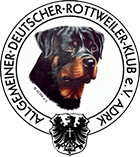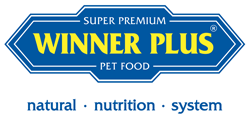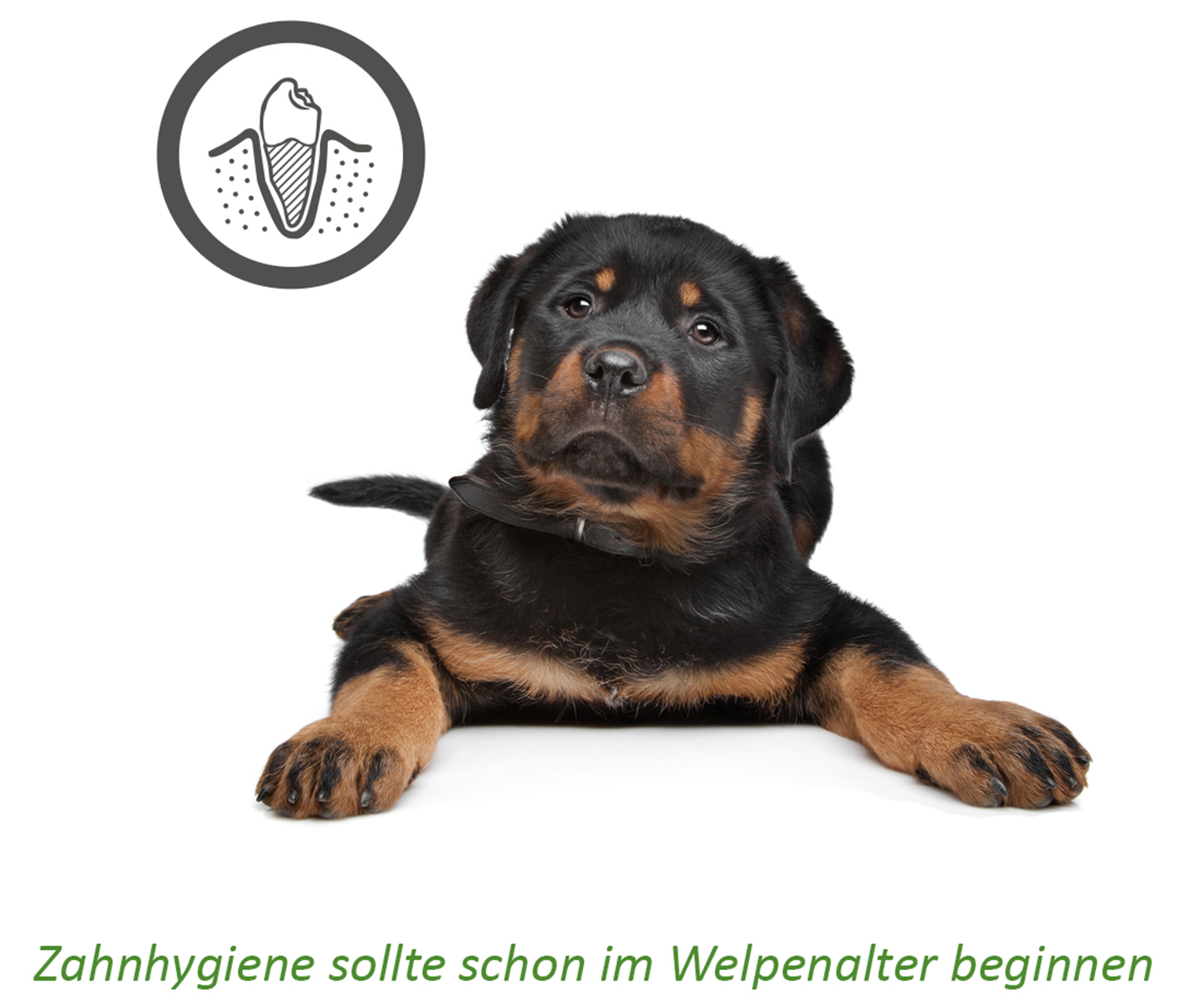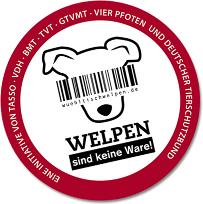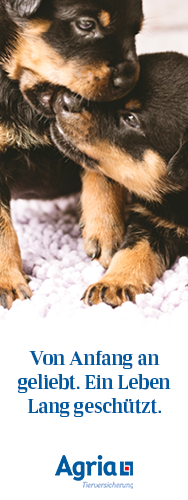| ADRK |
| Allgemeiner Deutscher Rottweiler-Klub e.V. |
Feel the dog on the tooth
A wet kiss is the way dogs greet their humans with the enthusiasm they deserve. There is nothing wrong with that, as long as the mouth hygiene is right. However, if the dog has bad teeth and spreads a bad smell, the joy of reunion is quickly over. At the latest then a critical look into the dog's mouth becomes unavoidable. Read what you can do for the dental health of your Rottweiler in this article!
The teeth of the dogs and how it works
The teeth of the dog consist, similarly as with humans, of the root anchored in the jaw and the crown projecting over the gums. They are covered with hard enamel. The teeth are attached to the jawbone via a special periodontium. The teeth are responsible for crushing the food. The surrounding gums together with the lips, palate and tongue form a protective system, which in combination with the saliva protects the teeth from damaging influences.
Puppies are born toothless. The milk teeth break through approximately from the 3rd or 4th week of life and are complete after 6 weeks with 28 teeth. Between the 3rd and 7th month of life, these fall out again in the course of the tooth change. With large dog breeds such as the Rottweiler, the tooth change is usually completed relatively early. The teeth of the adult dog have a total of 42 teeth, with each side of the jaw consisting of three incisors, one canine tooth and six upper and seven lower molars respectively. With its pointed teeth, it is originally a typical carnivorous set of teeth, but according to the type of domestic dogs it is also quite suitable for chewing up parts of plants - dogs are not pure carnivores, but functional omnivores. Upper and lower jaw interlock like scissors. The incisors of the lower jaw stand thereby behind those of the upper jaw, while the lower fangs stand before the upper ones. The lips, i.e. the lips of the dog, normally close off the mouth completely. Some breeds are prone to malocclusion of the teeth, anomalies in the number of teeth, and anatomical features in the shape of the lips, such as heavily sagging lips. These deviations from the original anatomy of the wolf may promote certain dental diseases.
What causes teeth disease
Due to the shortened and compact muzzle shape, Rottweilers tend more often to jaw anomalies such as the forebite. Malpositions of individual teeth can also occur. In puppies and young dogs, surplus teeth or jaws that are too narrow, persistent milk teeth and malpositioned teeth can result in the entire row of teeth not having sufficient space in the jaw and individual teeth shifting. Faulty teeth carry the risk of food residues getting stuck and causing inflammation. In addition, they can cause bites in the gums if the corresponding opponent of the tooth is missing. In these sore areas, more food remains and dirt are deposited and pronounced centres of inflammation can develop. A frequently occurring anomaly is the "Caninussteilstand", with which the fangs (Canini) stand vertically upwards deviating from their slightly inclined position and bite into the palate behind the upper incisors. Even the palate bone can be damaged by the power of the pointed teeth, because dogs feel the pain of the bite, but have no adequate possibility to avoid it.
Intensive stick games, chewing on stones or similar activities can cause tooth fractures. Either a piece of the tooth crown breaks off, which in the worst case leads to the opening of the tooth pulp and the tooth nerve, or the tooth enamel tears, often in longitudinal direction, whereby even the root can be damaged. Also, in relatively young dogs, ground teeth usually result from chewing on stones. A dysfunction infection during the change of teeth also results in pronounced enamel defects on the teeth. Today, however, this disease has become very rare due to vaccination programmes.
In contrast to humans, caries diseases hardly play a role in dogs. Other dental diseases are much more common. Middle-aged dogs and senior citizens often suffer increasingly from tartar. Rottweilers are less susceptible to tartar than smaller dog breeds, for example, but the teeth of the Rottweiler should be checked regularly for tartar formation. After each feeding, bacteria-containing soft plaques form on the teeth. Due to the natural flow of saliva, the teeth are normally cleaned continuously. In some dogs this mechanism is sufficient to keep the teeth healthy, in others excessive plaque develops over time due to various factors, which store minerals and thus transform into hard tartar. Breed-related, feed-related and disease-related factors play a role here. The exclusive feeding of moist food contributes to the formation of plaque just as much as all diseases that weaken the environment in the mouth and the local immune system, such as kidney disease or immune deficiency. Tartar promotes the nidation of bacteria and thus gum inflammations (periodontitis), it leads to the formation of gum pockets and the regression of the protective gums, and causes tooth loosening due to the damage of the complete periodontium. Finally, the decomposition products of the fixed bacteria also cause a bad smell from the mouth cavity of the dog.
Once infectious pathogens have settled in the mouth, there is always the risk that they will enter the bloodstream via small lesions of the gums and settle in other parts of the body. The heart is particularly at risk here. When germs attach themselves to the heart valves, they lead to inflammation (endocarditis) and damage the natural function of the heart. However, this disease mainly affects smaller breeds of dogs.
Gum abnormalities such as "epulids" can also endanger dental health. Epulids are benign gum growths that promote the accumulation of food residues and plaque. Malignant, tumorous growths are less common.
If only the veterinarian can help
Even with mild to moderate tartar formation, removal of the plaque using special ultrasound technology is unavoidable. Although this method is painless in principle, dogs have to be anaesthetized in contrast to humans, because they would not like to undergo the tedious procedure elsewhere. Gum growths are usually removed using laser technology or electrosurgery, so that only minimal bleeding occurs. If individual teeth are already so badly damaged by inflammatory processes that they become loose or the tooth necks are exposed, they must be removed. In the case of extensive inflammations and infections with pus formation in the jaw area, additional antibiotic therapy is sometimes necessary. To avoid such major procedures, dogs that are prone to tartar formation should have their teeth restored by a vet once or twice a year. After this treatment, the teeth are finally polished with a special paste to close minor defects in the enamel.
Since malpositioned teeth can also lead to tartar formation and gingivitis, the correction of these anomalies already in the young dog age a special importance. Some veterinarians have specialized in such orthodontic treatments. They use glued-on braces and occlusal splints or expansion screws, which are regularly adjusted by the veterinarian over a certain period of time. In some cases, the use of special chewing or pulling toys, which can compensate for slight malpositioned teeth or jaws in young dogs during growth when used several times a day, is also sufficient. For more severe jaw anomalies, it may also be necessary to pull healthy teeth to give the remaining teeth enough space in the jaw. In most cases "supernumerary" teeth are located outside the row of teeth anyway and do not fulfil any function, but promote the adherence of food residues. Persistent milk teeth, which stand next to the corresponding permanent tooth or even prevent it from growing out, must also be removed after a certain age.
Prevention is better than cure
As a dog owner, you can do a lot to maintain the dental health of your Rottweiler. Already with the puppy the teeth should be checked regularly, in order to recognize tooth malpositions early. Already the first vaccinations with the veterinary surgeon offer themselves to let check the teeth of the puppy.
Continuous dental care is particularly important. To remove soft plaque that accumulates on your dog's teeth after every meal, you should brush your dog's teeth daily, but at least three times a week. It is best to choose a time before a longer "feeding break", for example in the evening after the last feeding. Get your dog used to this procedure at an early stage and not only when problems arise, so that he does not associate something unpleasant, such as toothache, with brushing his teeth. The question of whether to use toothpaste for dogs often arises. Toothpastes made for humans are usually too sharp for dogs. In addition, they often contain fluoride or xylitol (xylitol) to prevent tooth decay, but these ingredients are toxic to dogs even in relatively small amounts. Children's toothpastes sometimes contain sugar for a better taste and are therefore counterproductive. Special toothpaste for dogs often does not contain any information about the ingredients, so that one must expect undesirable additives of sugar, artificial flavors or allergenic substances. Simply brush your teeth with lukewarm water or ask your vet for a suitable toothpaste for dogs. If your dog does not like the procedure with the toothbrush, you can alternatively use special finger cots with a brush and brush the teeth with a finger. Special tooth gels, which are put into the mouth cavity without brushing, can also reduce the plaque formation with suitable composition, whereby the dissolving of tartar with these gels appears to be very questionable. Here, too, you should only use products recommended by your vet.
Furthermore, various chewing articles are offered on the market which are intended to prevent the formation of tartar. Chewing bones, which for example are made from cattle skin or other connective tissue animal products, are well suited for tartar prophylaxis, as they enable longer chewing. However it is to be considered that in particular beef frequently releases allergies and here, straight with Allergikern, special caution is necessary. Other specially manufactured chewing products for dogs promote the abrasion of plaque during chewing, comparable to the effect of brushing teeth. In most cases, however, the chewing process is only of short duration. In order to guarantee a certain consistency of these articles, however, they often contain many carbohydrates or sugars. This means that large amounts of additional energy ("calories") are absorbed, which can lead to obesity, especially in small dogs.
Don't forget the right diet
Both the ingredients of the feed and the composition of the feed components are of great importance in tartar prophylaxis. The composition of the feed should be balanced in order to support the function of the periodontium and the local immune system in the oral cavity. Frequent administration of treats throughout the day should be avoided, sugar-containing treats and food leftovers are generally discouraged. In order to promote the abrasion of dental plaque, dry food should be given preference over moist canned food, whereby chewing uncrushed meat, for example in a balanced self-prepared ration, can also support dental health. However, this abrasion effect only has a preventive effect; already existing tartar is not removed by chewing. The food crumbs should be sufficiently large and firm so that the dog must chew them up and not simply gulp them down. An increased fibre content in the food also contributes to increased chewing activity and tooth cleaning. In addition to the abrasion of plaque, chewing also promotes the formation of saliva. Special ingredients of the food can also promote dental health. Polyphosphates, which are incorporated into the outer shell of the feed bricks, trap free calcium in the mouth cavity and thus prevent the calcification of dental plaque, thus preventing the formation of tartar. Metal salts such as zinc sulphate also work according to a similar principle. Eucalyptus oil does not only smell pleasant, but it also contains special antibacterial agents which eliminate the cause of plaque and tartar and thus directly prevent bad odours from the mouth cavity.
